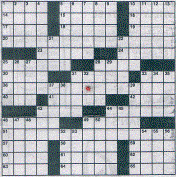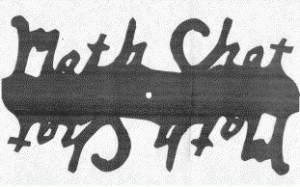WHY IT’S HARD TO FOLD A TRIANGLE IN HALF
June 4, 1999
OLD CHALLENGE (John, RiverGlen School). For a circular piece of paper, the lines along which you can fold it “in half” (with half the area on each side) are precisely the lines through the center. What other shapes work the same way?
ANSWER. This works for lots of shapes, such as rectangles, parallelograms, regular hexagons, and ellipses, but not for others, such as triangles and most irregular shapes. Eric Brahinsky best explains that any shape which is symmetric about a point (that is, under 180-degree rotation about the point), can be folded in half along any line through the point. His interesting examples in Figure 1 include a crossword puzzle square (with small, darkened squares symmetrically removed) and a Math Chat logo. Elliot Kearsley proves that such symmetric shapes are the only examples among smooth, convex regions.
Eric Brahinsky submits two interesting symmetric shapes which can be folded in half along any line through the center.
Funny things can happen if you allow regions with several pieces to them or with holes in them. A region consisting of two small unit discs, the second to the right of the first, can be folded in half along any vertical line between them. There are certain nonsymmetric rings around the origin which can be folded in half along any line through the origin.
NEW CHALLENGE (inspired by Wiley Miller). Player A writes three different integers, positive or negative, on three pieces of paper and turns them over one at a time. Player B selects one of the three when it is turned over, trying to pick the middle value. What are B’s chances of winning? What are the best strategies? (What if B’s goal is to pick the largest value?)
Send answers, comments, and new questions by email to [email protected], to be eligible for Flatland and other book awards. Winning answers will appear in the next Math Chat. Math Chat appears on the first and third Thursdays of each month. Prof. Morgan’s homepage is at www.williams.edu/Mathematics/fmorgan.
Copyright 1999, Frank Morgan.


 Welcome to my blog. I also have a blog at the
Welcome to my blog. I also have a blog at the